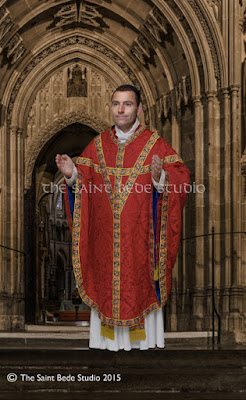 |
Figure 1. Pope Paul VI in 1978
wearing a rose chasuble
made from dupion silk.
Image: L'Osservatore Romano
|
Twice a year, the Church breaks the tone of its penitential seasons by the use of rose-coloured vestments. Rose-coloured vestments were never commonplace and they still are not. Nevertheless, you will find various pronouncements these days (usually on websites) about what the real or authentic shade of rose is which is to be used for vestments.
Newsflash:
there is no official shade of Rose designated by the Church, nor has there ever been. One reason for this is rather simple: only in the nineteenth century did the process of dyeing fabric become sufficiently sophisticated to ensure that much the same shade of a colour emerged from one batch of fabric dyeing to another.
Many different colours have been deemed by the Church as acceptable as liturgical Rose. Some of these are a salmon shade; some a silvery-pink, almost mushroom-colour; some close to what we would call Bishop's purple or
fuchsia.
Another thing is certain:
Bubblegum Pink is not Rose, nor has it been a traditional variation for use on these days. Whilst not intending to get into the argument as to whether the use of pink (be it vibrant or subdued) is a fitting colour for a man to wear,
Bubblegum Pink certainly manifests a lamentable lack of liturgical good taste. And yet we find so many pink vestments for sale from ecclesiastical suppliers etc.
 |
Figure 2. Pope Paul VI greeting a priest
after Mass in Saint Peter's on Laetare Sunday 1978.
Both are wearing rose
chasubles made from dupion silk.
Image: L'Osservatore Romano
|
At an old post on the Blog,
The New Liturgical Movement, we find a number of interesting vestments in that shade of Rose commonly found in Italy in centuries past: a salmon colour. Go there and take a look. But don't be mistaken about that particular shade of Rose being universal: it was used in Italy, but probably not much elsewhere.
Adjacent are two pictures of another shade of Rose. These are sets of vestments worn by Pope Paul VI on Laetare Sunday, 1978. The vestments are made from dupion silk of a very subdued silvery-rose. Ornamenting them is a column-orphrey almost fuchsia in colour. Sadly, these vestments have not been seen in Papal Masses of recent years: lamentable sets of brighter pink vestments, of rather unimaginative fabric and design, have been used instead (not to be looked at before breakfast).







